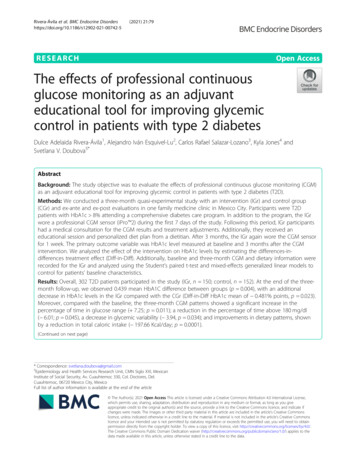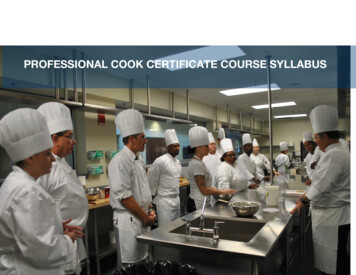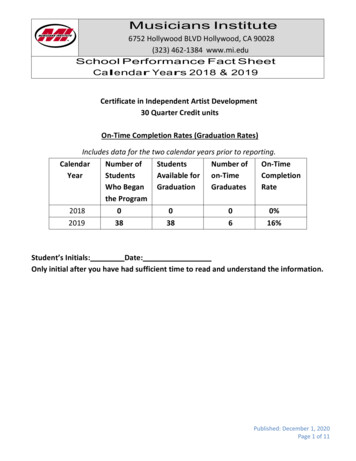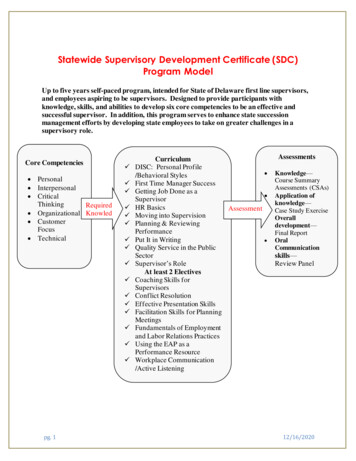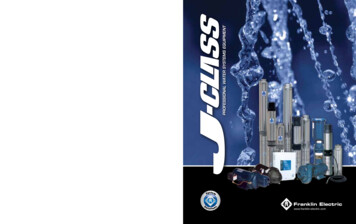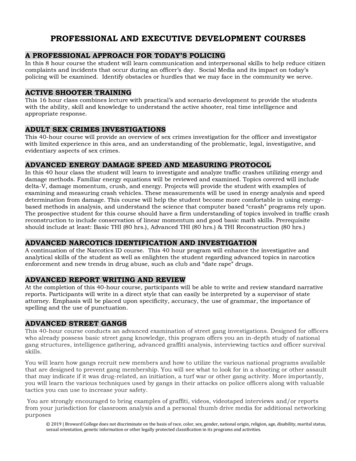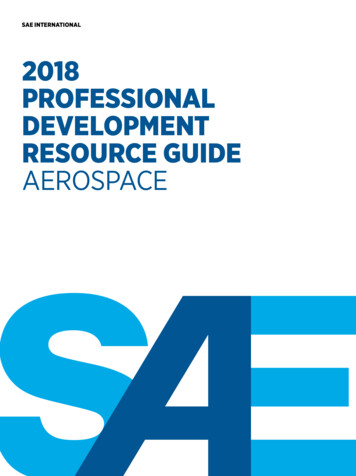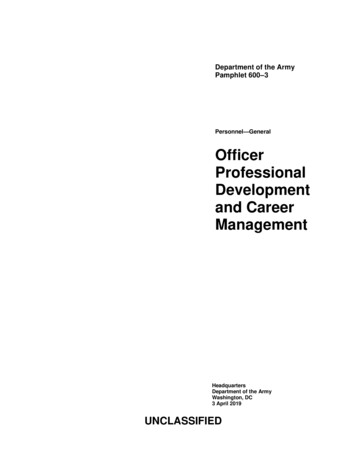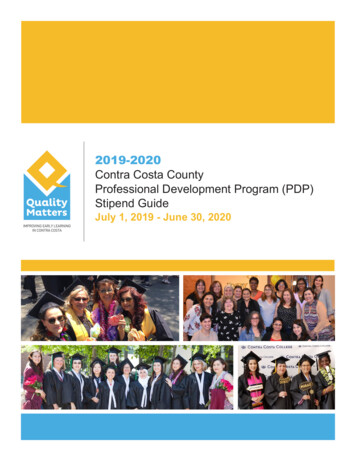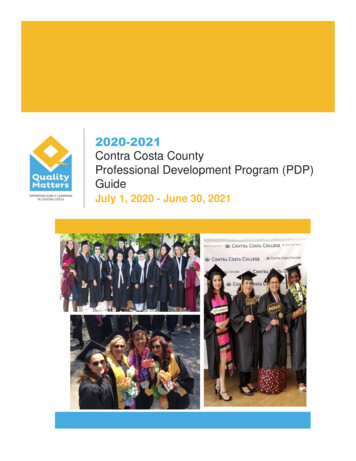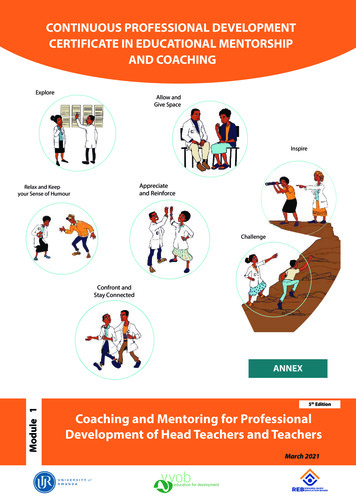
Transcription
NUOUSDEVELOPMENTCERTIFICATEIN EDUCATIONALMENTORSHIPCERTIFICATEIN Allow andGive SpaceInspireAppreciateand ReinforceRelax and Keepyour Sense of HumourChallengeConfront andStay ConnectedStudy ManualANNEXModuleModule1 14th EditionLeading and Managing for g ofandMentoringfor andProfessional5th EditionFebruary2020Development of Head Teachers andTeachersMarch 2021iREBRWANDA BASICEDUCATION BOARD
ii
RwandaREBREBEducation BoardRWANDA BASICRWANDA BASICEDUCATIONBOARDEDUCATION BOARDContinuous Professional Certificatein Educational Mentorship andCoachingANNEXModule 15th EditionCoaching and Mentoring for Professional Developmentof Head Teachers and TeachersMarch 2021i
Please cite this publication as:UR-CE (2020) Continuous Professional Development Certificate in EducationalMentorship and Coaching (CPD-EMC), Student Manual, Module 1: Coaching andMentoring for Professional Development of Head Teachers and Teachers, 5th edition,Kigali.Copyright NoticeThis material is licensed under an Attribution-Non-Commercial-Share Alike CreativeCommons License. This means that you can remix, tweak, and build upon the worknon-commercially, as long as you credit this work and license your new creationsunder identical terms.Designed & Printed byTechno Market Ltd www.technomarketrwanda.comKN 82st, Kigali City2
Table of ContentsAnnex 1: Policy framework for CPD for (head) teachers. 1Annex 2: Stakeholders involved in School-Based CPD and induction of NTs in Rwanda. 3Annex 3: Reflection models. 7Annex 4: Report template for a reflection. 10Annex 5: Teacher competences (professional needs self-assessment). 12\Annex 6: Template CPD plan. 21Annex 7: REB’s lesson observation tool. 24Annex 8: Guidelines on lesson preparation and teaching under physical distancing and other preventivemeasures. 32Annex 9: Guidelines on lesson preparation for remote teaching and learning. 34Annex 10: CoP sessions overview. 36Annex 11: Report template for a CoP cycle. 39Annex 12: Stakeholders in CoPs and their roles. 46Annex 13: Report template for a coaching conversation. 51Annex 14: Checklist induction activities/programme via TTC tutor. 53School visit: A) School and new teachers’ information. 53School visit: C) Checklist induction activities/programme. 54School visit: D) Checklist NTs’ professional development needs. 54School visit: E) TTC and in-school mentor information. 55School visit: B) Observing in-school mentor - Option 1: Lesson observation of a NT teaching Info:. 56School visit: B) Observing in-school mentor - Option 2: Lesson observation of a mentor or experiencedteacher teaching with a NT observing Info:. 61School visit: B) Observing in-school mentor - Option 3: CoP for new teachers or focused on new teachersInfo:. 68School visit: F) Debriefing with the main key actors. 70School visit: G) Conclusion of the supportive visit. 71Annex 15: Observing in-school NT mentor’s practices related to a lesson observation. 72Annex 16: Guiding questions to evaluate the TTC support to new teachers’ induction. 73Annex 17: Competence profiles of stakeholders involved in the induction of NTs. 74Annex 18: Competence profile of the Sector Education Inspector as coach of head teachers. 78References. 81SET READINGS. 82iii
4
Annex 1: Policy framework for CPD for (head) teachersThere are 4 main Rwandan educational policies that support CPD:1) Rwanda Vision 2020:One of the foundations of Rwanda’s Vision 2020 is to have skilled people for the socio-economicdevelopment of the country. This foundation underlines the importance of education and training inproducing knowledgeable citizens with skills and attitudes that would enable them to be entrepreneursin their own learning, thinking and doing. Improving the quality of education and training is one of theoverall goals of the Ministry of Education. Quality of education depends on many factors, but teachersand school leaders are the two most important actors in raising this quality. Therefore, priority is given toteacher development and management (MINECOFIN, 2000).2) Education Sector Strategic Plan 2018/2019 – 2022/2023:This strategic plan is structured around 9 strategic priorities. Priorities 2 and 9 have a particular focus onCPD for (head) teachers: Priority 2: Strengthened continuous professional development and management of teachersacross all levels of education in Rwanda. This priority plans to introduce a complete set of schoolbased CPD for all categories of teachers. The new approach of CPD for teachers will focus onimproving the professional competences of teachers required to deliver the new competencebased curriculum. A sub-element of this strategic priority is to improve teacher managementpractices. This includes the deployment, staffing norms, transfers, keeping teachers in theprofession and motivational strategies (MINEDUC, 2017); Priority 9: Strengthened governance and accountability across all levels of education in Rwanda.This priority says that head teachers will be trained and supported in school leadership to givethem enough skills to provide CPD for their teaching staff and plan for the school improvementand development. Head teachers also need to be able to identify strengths and weaknesses oftheir teachers and provide support and advice on pedagogy, subject matter, inclusion and othercross-cutting issues (MINEDUC, 2017).3)Teacher Development and Management Policy in Rwanda (TDM) (draft, 2015):This policy specifies that (head) teachers will be encouraged to improve their knowledge skills, competencesand qualifications upon completion of their first training through a structured programme of ContinuousProfessional Development (CPD) and Distance Learning (DL).The TDM-policy is structured around six policy priorities (PP). Three of them are directly related to CPD: PP3: Introduce a high-quality induction year for newly qualified teachers, and other than inexceptional circumstances, require all teachers to be ‘licensed’ (i.e., given official approval toteach) following the successful completion of their induction period; PP4: Require all teachers to implement and record Continuous Professional Development (CPD),and ensure that an effective system for appraisal, mentoring, support, assessment, and re-licensingfor all teachers is put in place to support it; PP5: Improve school leadership quality and training (MINEDUC, 2015; 14).Furthermore, this policy wants to further professionalise teaching in Rwanda, based on ‘the belief1
that teaching is a distinct and valued profession within the public service, governed by its own code ofprofessional ethics, and having clear ways for professional and personal development’. Four principles ofteacher development and management reflected in the TDM policy are:- teacher development is a career long process;- every teacher has different needs;- teacher development and management are a shared responsibility among teachers and employersat different levels;- teacher development and management depend on all stakeholders’ creativity, proactivity(controlling a situation by causing something to happen rather than waiting to respond to it afterit happens), flexibility and resourceful planning (MINEDUC, 2015; 10).4) The School Based Mentor Programme Framework (REB, 2016)The SBMPF underlines that teachers will need to learn new methodologies to increase the quality of theirteaching, (and therefore the quality of learning) that takes place in their schools. In this framework, CPDwill have several forms at the school and sector level. For example, School Based In-service training (SBI),Communities of Practice (CoPs), peer lesson observations, model lessons, self-study, formal training fromREB and other courses and workshops (REB, 2016).The objectives of the SBM programme are to: Provide a highly trained resource person at the school level to organise and provide in-serviceteaching professional development in all areas, as needed; Maintain a team of qualified English-speaking teachers who are competent in competence-basedpractices; Install systems for school-based professional development and support the cycle of improvingteaching by learning from experience and sharing best practice (REB, 2016; 6).2
Annex 2: Stakeholders involved in School-Based CPD and induction ofNTs in RwandaSchool-based Mentoring Programme (SBMP) describes the responsibilities of the stakeholders involvedin school-based CPD. Based on those stakeholders’ responsibilities, interviews with SEIs and focus groupdiscussions with teachers, NTs, parents and head teachers, specific responsibilities for the induction of NTshave been identified.Responsibilities in SBMPFResponsibilities in induction of NTsTeachers Keep personal record of training received Actively Participate in CPD -training/sharinggood practice with peers Implement new teaching methods learned in Provide support and guidance through CoPs Conduct peer lesson observations and modellessontraining. Ask for support from peers, SSLs and SBMswhen needed Improve skills in English as a Medium ofInstruction Monitor learners’ progress through formativeand summative assessment to understand theimpact of new methodologies on quality ofteaching and learning in their class.School Subject Leaders Provide suggested CPD Action Plan for theterm supported by SBM to Deputy HT Report CPD activities conducted during theterm to Deputy HT Work with SBM to assess CPD needs, especiallyfor specific subject content Collaborate with SBM to facilitate CPD sessionsfor their subjects Work with SBM to help improve subjectspecific English for teachers (e.g., vocabulary) Support teachers to develop Teaching &Learning materials in particular subjects, givemodel lessons, develop teaching aids Under direction of Deputy HT, conduct modellessons Experts in teaching their subject are informedof innovations and stimulate learning fromeach other by organising team teaching,lesson observations and discussions on goodpractices and give special attention to NTsteaching the same subject. They express beliefs in their professionalgrowth and stimulate try out for newapproaches, support NTs in lesson planningand coach them to improve their capacities,give special attention to improve the languagecapacities of NTs in teaching their subjectand stay in contact with the SBM for effectivementoring of the NTs.3
School Based Mentors as a coach in English: assist all teachers to improve the quality of their English-language skills for use as a language ofinstruction facilitate teachers’ use of English self-study materials to assist peers (colleagues) to improve theirEnglish proficiency expert in teaching and learning are informed and inspired by innovations in education show personal leadership in professional development, which makes them role models for otherteachers in CPD guide and organiser of school based CPD promote the development of teachers in order to improve students’ learning and to improve theschool as a learning organisation organise CPD-activities in school and set up learning communities to encourage best practices provide support to NTs to facilitate their integration in the school community and to support theirgrowth as teacher. Therefore, SBMs connect NTs to colleagues, who can take an active role inmentoring NTs promoter of reflection stimulate reflection and facilitate giving of feedback on the quality of teaching and learning at school encourage teachers to reflect on their own teaching. Teachers can then improve their teachingpractices by focusing on building on strengths and overcoming weaknesses. In this way, SBMsstimulate the capacity for continuous professional development of all teachers in the schoolDeputy Head Teachers Supervise and support SBM and SSL work Approve CPD plan submitted by SBM and SSLs,and forward to HT Assist SBMs to find resources for CPD activities Assist Head Teacher in preparing and analysingmonthly reports Conduct lesson observations, CPD meetings,model lessons and training as part of schoolCPD plan Teach classes (6 periods or 340 minutes perweek) to allow SBM reduced load4 Give NTs a warm welcome and present themto the SBM, SSLs, the colleagues, the parentsand the children Collaborate with SBM and SSLs and the wholeschool community to demonstrate their beliefin the capacity and growth of the NTs
Head Teachers Organise academic staff to select a mentor Make time for CPD and mentoring activities onthe school timetable Discuss CPD training needs of school staff Work together with SBM, teachers and DeputyHead Teacher/DoS to develop a CPD plan forschool Work with Deputy HT to supervise SBMactivities Monitor SBM and CPD activities and sendreports to SEI each term Motivate teachers to improve quality ofeducation in their school Provide necessary resources Teach classes (6 periods or 340 minutes perweek) to allow SBM reduced load Give NTs a warm welcome and present themto the SBM, SSLs, the colleagues, the parentsand the children Collaborate with SBM and SSLs and the wholeschool community to demonstrate their beliefin the capacity and growth of the NTsSector Education Officers Communicate information from district toschool and vice versa Regularly collaborate with Head Teachers tomonitor SBM work Report on CPD activities Co-ordinate and implement SBMP and CPDactivities at the sector level: e.g., sector levelcommunities of practice for peer learningbetween SBMs and teachers Ensure that school leaders are focused on theprofessional development of NTs by effectivelyimplementing an induction programme Are involved and take their responsibility inthe recruitment of teachers Pay attention to NTs wellbeing by speakingin favour of timely payment of salaries andguaranteeing medical insurance by the districtDistrict Directors of Education & District Education Officers are responsible for facilitating, organising and Ensure that every public school in the districtscheduling the process of recruitment and forhas a SBMthe deployment of the NTs Through DCC, select qualified Mentor Trainers ensure quality of the NTs’ inductionbased on REB guidelinesprogramme Facilitate and support SBMP and CPD activities are attentive to NTs well-being i.e. by payingin the districtthe teachers’ salaries on time, supporting Ensure every school has resources necessary toaccommodation and guaranteeing healthimplement effective SBMP and CPD activitiesinsurance coordinate all educational activities at districtlevel in relation to NTs through the DCC,District Continuous Professional DevelopmentCommittee5
Development Stakeholders Support trainings for SBMs and SSLs, schoolleadership, district education stakeholders Assist in developing communities of practicefor SBMs Provide technical support (financial andresources) for development of materials(English, pedagogy, and mentoring skills)University of Rwanda College of Education Stakeholder with REB to provide ContinuousProfessional Development Diploma in Englishfor teachers Stakeholder with REB to provide ContinuousProfessional Development Course onmentoring and coaching Supervise monitoring & evaluation for theDiploma courses, provide certificates NT mentors from URCE monitor the performance of NTs during theirfirst year of teaching (induction period) stimulate reflection and give feedback in apositive way (on teaching activities) plan/organise trainings for SBMs and SSLson mentoring with a focus on reflection andcoaching techniques monitor the induction process of NTsRwanda Education Board Produce & distribute training materials forMTs and SBMs Coordinate and plan training of SBMs throughInspectors, support and collaborate withschools in monitoring of the SBMP Collect and analyse monitoring reports fromdistrict Provide training to district, sector, and schooleducation leaders to enable them to take uptheir roles and responsibilities support and monitor the induction of NTsthrough:o development of a policy and long-termstrategy for strengthening the inductionsystem for NTso development of competence frameworksfor teachers based on professionalstandardso development of operational manuals onvarious topics related to effective teachingand learningTTC tutors as NT mentors monitor the performance of NTs during theirfirst year of teaching (induction period) stimulate reflection and give feedback in apositive way (on teaching activities) plan/organise trainings for SBMs and SSLson mentoring with a focus on reflection andcoaching techniques monitor the induction process of NTs6
Annex 3: Reflection modelsALACT modelThe ALACT model describes the way teachers and other professionals learn. It contains five stages asshown in figure 1:(1) action(2) looking back on the action(3) awareness of essential aspects(4) creating alternative methods of action(5) trialFigure 1: The ALACT model of reflection (Korthagen & Vasalos, 2005). Stage 1 of Action: ALACT model is all about action. You can reflect on theory as much as you like buttrue learning occurs when the reflection is done in concrete experience. Stage 2 of looking back on the action: In this stage, you look back on the action. The followingquestions are useful:- What was the context?-What did you want? What did the participants want?-What did you do? What did the participants do?-What were you thinking? What were the participants thinking?-How did you feel? How did the participants feel?7
Stage 3 of Awareness of essential aspects: In this stage, you’re meant to make sense of the experienceby seeing the implications of it and the meaning of it. Stage 4 of creating alternative methods of action: In this stage you take the significance and implicationsfrom the previous stage and ask “Now what?”: “How could my practice change as a result of theinsights I’ve had?” Stage 5 of Trial: The final aspect of the ALACT model is to plan to trial these new modes of action. Andin this way the cycle starts all over again (Ingram, 2015).Kolb’s model of experiential learningKolb’s model of experiential learning is another form of the reflective cycle. It begins with the learningexperience. The practitioner then reflects on this and develops a theory of learning, concluding fromthe experience. This leads to experimentation and the trying out of new ways of working, which in turnprovide further experience and the opportunity to reflect. The model is composed of four steps as adaptedby research (White et al., 2009):1) Concrete experience: doing, having an experience - what happened?2) Reflective observation: reviewing, reflecting on the experience - why did it happen that way?3) Making an abstract concept: concluding, learning from the experience - what can I learn from this?4) Active experimentation: planning, trying out what you have learnt - how do I plan to improve?Figure 2: Kolb’s model of experiential learning (1984) as adapted by White et al. (2009)8
Gibbs’s reflective cycle modelThe Gibbs’ reflective cycle (1988), inspired partly by Kolb’s learning cycle, helps us to focus especially onour own and others’ feelings and points of view. In common terms people call this “Standing/walking insomeone else’s shoes”. This relates strongly to ideas about empathy. The process is essentially a cyclecontaining the following elements:1) Description: what happened?2) Feelings: what were you thinking and feeling?3) Evaluation: what was good and bad about the experience?4) Analysis: what sense can you make of the situation?5) Conclusion: what else could you have done?6) Action Plan: if it happened again what would you do? (back to 1 Description)Figure 3: Gibbs’s reflective cycle (1988)9
Annex 4: Report template for a reflectionReport on reflective practice (self-reflection)Name of the SBM:Topic of reflection:Date of the reflection:WHAT modelWHAT?What happened?I describe my and other’s experienceand actions: What was my role? What did I do? What did others do?SO WHAT?What can I learn from this?I analyse and reflect on my experience: What was so important about thisexperience? Why did it happen that way? What did I learn?NOW WHAT?How will I use what I have learnt infuture practice?I draw conclusions after reflecting onmy experience: What do I change to make thisexperience better? What will be my new actions? What will be the consequences ofmy new actions?10Reflection notes
Report on reflective practice (supporting peer reflection)Name of the SBM:Name of teacher:Topic of reflection:Date of the reflection:WHAT modelTeacher’s reflectionSBM’s feedbackWHAT?What happened?Describe your and other’sexperience and actions: What was your role? What did you do? What did others do?SO WHAT?What can you learn from this?Analyse and reflect on yourexperience: What was so importantabout this experience? Why did it happen that way? What did you learn?NOW WHAT?How will you use what you havelearnt in future practice?Draw conclusions afterreflecting on your experience: What do you change tomake this experience better? What will be your newactions? What will be theconsequences of your newactions?11
Annex 5: Teacher competences (professional needs self-assessment)Domain 1: Knowledge and understanding self-assessmentStandard 1: Knowledge and Understandingof the Curriculum and Subject Matter1The Competence-Based Curriculum, itsprinciples and pedagogical approach2Subject syllabus and key learningoutcomes for school level and gradestaught3Basic and generic competencies withinand between subjects4The National examination system andexamination criteria for subject/s5Key concepts, skills and competencesfor subject/s taught and links betweenthem6Real world applications of subject/s8Relevant spoken and written forms ofthe language of instruction9Principles of language teaching andlearningStandard 2: Knowledge and Understandingof Teaching and Learning1Teaching and learning strategies forsubject/s and grade/s2Strategies for teaching and learning inlarge and/or mixed ability classes3Strategies for teaching children withspecial educational needs12I need moreI don’t knowinformationthisabout thisI know thisI master thisfullyI need moreI don’t knowinformationthisabout thisI know thisI master thisfully
4Strategies to support language learning5Strategies for teaching thinking skills,and learning approaches related tosubject/s6A variety of course-books, locallyavailable resources and ICT forsubject/s grade/s7How to select/adapt/make and use ofTLMs for learning for subject/s grade/s8Strategies to organise, store and shareTLMs with colleagues and learners9Strategies to guide learners in the safeand sustainable use of TLMsStandard 3: Knowledge and Understandingof Students1The intellectual, physical and emotionaldevelopment of learners2How learners develop knowledge, skillsand attitudes3How learners’ backgrounds, currentknowledge, skills and attitudes informlearning4Strategies to identify and build onlearners’ current knowledge, skills andinterests5Barriers to learning and participationlinked to gender, SEN, and learners’backgrounds6Strategies for identifying andovercoming barriers to learning andparticipation7The abilities, interests, needs and socialbackgrounds of your learnersI don’tknow thisI need moreinformationabout thisI know thisI master thisfully13
8Child protection and safeguardingpolicy and processes in your schoolStandard 4: Knowledge and Understandingof Instructional Planning1The importance of instructionalplanning2How to write unit plans and schemesof work using the Competence-BasedCurriculum3How to write lesson plans with clearobjectives, and measurable outcomes4How to plan activities which supportlearners to achieve learning outcomes5How to identify the language, conceptsand skills needed for participation inthe lesson6Strategies for working with colleaguesto plan assessments for teaching andlearning7How to adapt plans for differentlearners8How to ensure plans link to previousand future learning9Strategies for time management andto organise, store and share plans withcolleaguesStandard 5: Knowledge and Understandingof Learning Assessment and EvaluationStrategies1The importance of assessment forlearning, teaching and teacherdevelopment2A variety of activities and strategies forformative and summative assessment14I don’tknow thisI need moreinformationabout thisI know thisI master thisfullyI don’tknow thisI need moreinformationabout thisI know thisI master thisfully
3How to create/access and use valid,reliable and inclusive assessments4Strategies for working with colleaguesto use data5How to interpret assessment data froma variety of sources6How to use assessment data to providefeedback to learners and families7How to use assessment information toinform teaching and learning8Strategies to support learners withexam preparationWhat are the 5 knowledge topics that you want to improve?1.2.3.4.5.15
Domain 2: Professional practice Self-AssessmentPedagogical aspect 1: Preparation and PlanningSometimesOftenAlmostalwaysAlways1. I plan learning outcomes and appropriatelearning objectives which includecompetences for my lessons2. I plan the lesson based upon knowledge ofsubject matter, students, the community andcurriculum goals3. I keep the needs of learners with SEN in mindduring the planning of my lesson4. If needed, I can adapt my planning during thelesson5. The lesson objectives are adapted to thestudents in my class (level of understanding)6. I plan safe and effective use of teaching andlearning materials and room layout7. I plan assessment for teaching and learningPedagogical aspect 2: Lesson tenAlmostalwaysAlways1. I can apply my knowledge to help the learnersto achieve appropriate objectives2. I can create a learning experience that makesthe subject matter meaningful for studentsPedagogical aspect 3: Learners’ engagement andprogress1. All learners are actively engaged in the lesson,throughout the lesson and the time is usedwell2. I can engage students in active learning3. The needs of any learners with SEN areconsidered so that they are fully involved inthe activities and the learning4. Learners make significant (great) progresstowards the learning objectives includingcompetences and subject knowledge16
Pedagogical aspect 4: Learner-centred methodsenable all the learners to learn effectivelySometimesOftenAlmostalwaysAlways1. Nearly all learners develop new knowledge andunderstanding, skills and competences, at alevel appropriate to their ability2. The methods used by the teacher lead toexcellent learning3. I balance between teacher-directed andstudent-centred learning experiences4. I can engage students during instruction5. Nearly all learners including any learners withSEN achieve challenging learning objectives6. I design developmentally appropriate learningopportunities for all students7. I can differentiate (modify instructional plans)based on learners’ needs, meeting the needsof different kind of students8. I am sensitive to individual needs anddifferences9. I understand how to motivate students to learn(I know which factors motivate students tolearn)10. I can determine student learning problems11. Provide opportunity for learners to apply andextend their knowledge and competenciesPedagogical aspect 5: Management of learnersand learning environmentSometimesOftenAlmostalwaysAlways1. I can create a positive and supportive learningenvironment where learners are happy,motivated to learn, feel safe to ask questions,are not afraid of
1 Annex 1: Policy framework for CPD for (head) teachers There are 4 main Rwandan educational policies that support CPD: 1) Rwanda Vision 2020: One of the foundations of Rwanda’s Vis
